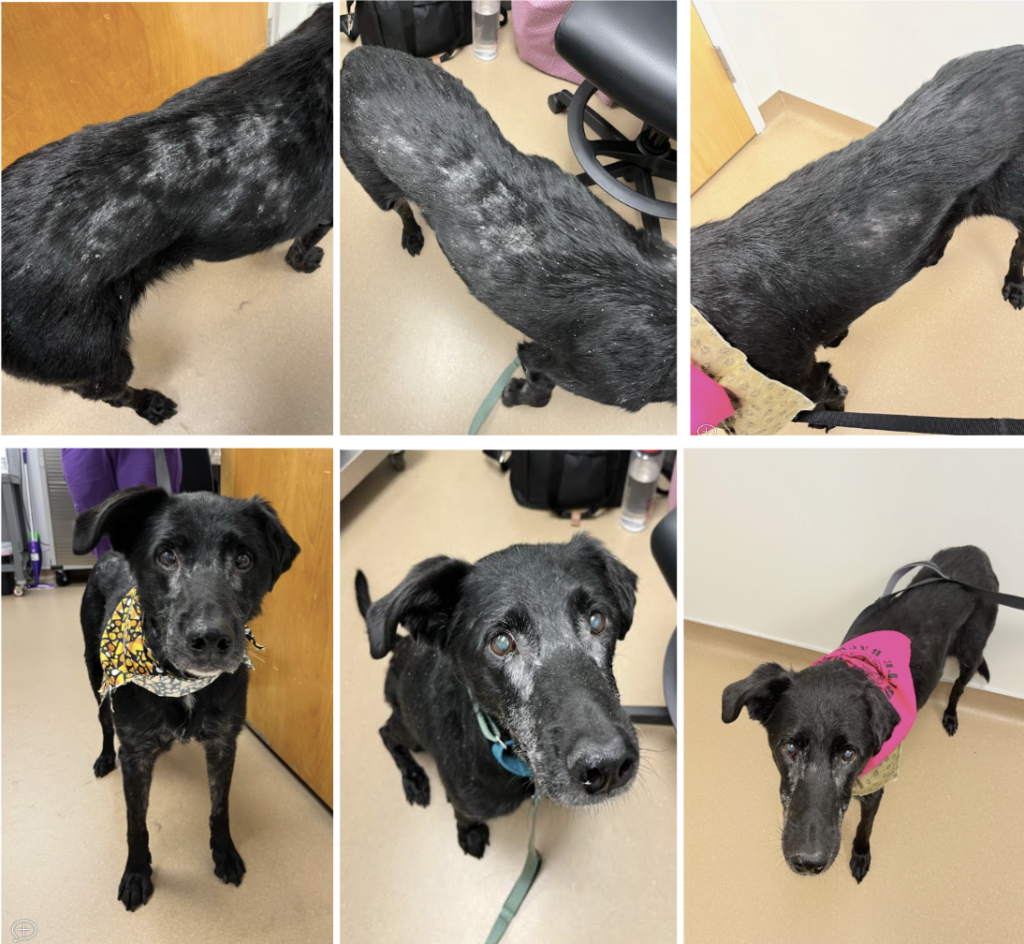Lucy was presented to our Oncology service for consultation following a diagnosis of cutaneous epitheliotropic T-cell lymphoma (CETL) via skin biopsies performed by her primary care veterinarian. In early August 2022, Lucy was presented to her primary care veterinarian for hair loss and seborrhea. Fungal culture yielded Microsporum vanbreuseghemii and bloodwork, which included T4, was unremarkable. Treatment with Atopica was initiated with minimal response. Lucy returned to her primary care veterinarian at the end of August 2022 for weight loss, at which time a skin scrape was negative for Demodex. She was treated with an injection of ivermectin and prescribed a medicated shampoo, oral antibiotics and steroids. Lucy’s cutaneous lesions persisted, so biopsies of the affected areas were performed in late September 2022, yielding a diagnosis of CETL. Referral to oncology was recommended at that time.
On examination at her initial consultation in November 2022, Lucy had diffuse non-erythematous scaling with multifocal to coalescing alopecia along her dorsum (see photo). Patchy alopecia and seborrhea was present along her face and all four limbs. She had a couple subcutaneous masses that were presumed to be lipomas and her lymph nodes palpated within normal limits. Further staging with chest X-rays and an abdominal ultrasound were recommended but were declined at that time.
The gold standard treatment for patients with diffuse CETL is a combination of prednisone and chemotherapy. The most commonly used first-line drug is an oral chemotherapy agent called lomustine (CCNU) administered once every 3 weeks until cancer progression or toxicity occurs. The median duration of remission reported for dogs with diffuse CETL and treated with lomustine is about 6 months. Since cancer cells in CETL are primarily confined to the skin, chemotherapy agents must be lipophilic in order to accumulate within the skin and be effective. Alternative therapies used in the management of CETL include oral retinoids (isotretinoin), Apoquel (anecdotal evidence of responses), Tanovea (injectable), and radiation therapy, among others. Lomustine rarely causes gastrointestinal upset but often causes marked bone marrow suppression (neutrophils and platelets) and liver enzyme elevations.
The owners elected to initiate treatment with lomustine and Lucy received her first treatment at the time of her initial consultation in November 2022. Lucy experienced a grade 3 non-febrile neutropenia 1 week after her first treatment and a grade 1 non-febrile neutropenia 3 weeks after her first treatment. Prophylactic treatment with Baytril was initiated and the frequency of her treatments was decreased to every 4 weeks to give her bone marrow more time to recover. The scaling over Lucy’s dorsum worsened after her first couple treatments, which is often observed in patients responding favorably to treatment as the affected skin begins to flake off. Lucy’s cutaneous lesions slowly resolved with each subsequent treatment (see photos).

Photographs of Lucy showing resolution of cutaneous lesions over the course of her chemotherapy treatment. Diffuse cutaneous lesions were observed at initial presentation on November 2, 2022 (LEFT). Following her first lomustine treatment, Lucy’s seborrhea and scaling appeared transiently progressive on November 9, 2022 (MIDDLE) before improving. Significant improvement was observed at the time of her second treatment, on December 7, 2022 (RIGHT).

Lucy appears to be in complete remission in February 2023 (LEFT) and June 2023 (RIGHT).
Treatment was discontinued after 6 doses due to persistent neutropenia that worsened after each subsequent dose. Alternative treatment options were discussed and the owners elected to transition her to monitoring. Lucy remained in remission until she was humanely euthanized due to mobility issues in April 2024. She was truly a cancer survivor and her story serves as a reminder that pets can have a great quality of life while undergoing chemotherapy and treatment may result in an unexpected favorable outcome!
Clinically Relevant Facts:
- The prognosis for cutaneous epitheliotropic T-cell lymphoma (CETL) varies depending on the extent of disease with diffusely affected patients experiencing short survival times.
- Treatment involves chemotherapy and lomustine (CCNU) is most often used as first-line therapy due to lipophilic properties that allow it to concentrate within the skin.
- The majority of patients experience cancer progression after 3-4 doses and alternative therapies, such as retinoids (isotretinoin), Tanovea, Apoquel (anecdotal evidence) and radiation therapy, among others, may be considered for continued management.
- Chemotherapy is generally well-tolerated and durable complete responses have been observed in some patients.
Authored by: Brittanie Partridge, DVM, PhD, DACVIM, Oncology